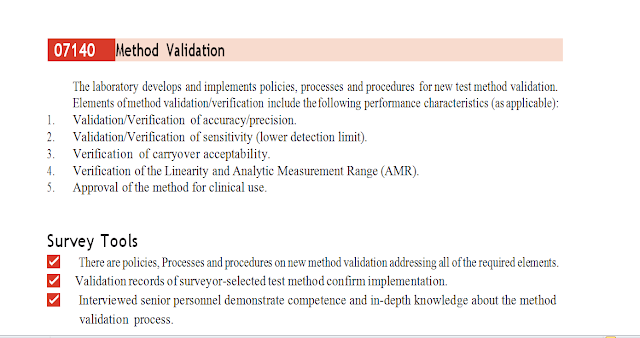بسم الله الرحمن الرحيم 7610 Gross Examination
..
وهنا لازم تحدد فى سياساتك ,Job description للفنيين أو من يقوم بال
... gross examination

وعلية
personal file ----- يحتوى على مايثبت صلاحيتهم لهذا من دراسة تخصصيه أو دورات وخبرات .....
Competyency ....من رئيس الوحدة يثبت أختبار مهاراته فى ذلك

**أن تحتوى سياسة العمل على الخطوات المتبعة فى هذة النقطة
o If the specimen is exceedingly tiny, please feel free to say “Note: specimen may not survive processing
********هذا ممكن تساعدكم فى عمل cheick list لل competency
اليوم هنبدأ بعض المعايير الخاصة ب مختبر الباثولوجى .....هل هذا معناه اننا لغينا معايير المختبر السابقة ...ابدا ..بل بالعكس يعتبر مختبر الباثولوجي من الوحدات المهمه جدا بالمختبر مثلها مثل بنك الدم في الاهميه ...وعليه ..بتقوم لجنه سباهي اثناء التقييم باستدعاء كل من رءيس بنك الدم ومختبرالباثولوجي ...الوحيدين ...دون الأقسام الآخري
ليعرضوا بنفسهم المستندات المطلوبه اثناء التقييم ...,وهذا يجعلنا نطبق معايير سباهي بمنتهي الدقه والعنايه علي وحده الباثولوجي وذلك من
1100-الي7280
وبالتالي معيار اليوم ماهو الا مراجعه لما سبق من ناحيه
Organization chart
وهنا لازم تحدد فى سياساتك ,Job description للفنيين أو من يقوم بال
... gross examination

وعلية
personal file ----- يحتوى على مايثبت صلاحيتهم لهذا من دراسة تخصصيه أو دورات وخبرات .....
Competyency ....من رئيس الوحدة يثبت أختبار مهاراته فى ذلك

**أن تحتوى سياسة العمل على الخطوات المتبعة فى هذة النقطة
GENERAL GROSSING GUIDELINES
While there is no substitute for the professional training and experience of the Pathologist, Pathology Resident, Pathology Fellow, Pathologists’ Assistant and Grossing Technician, and while there is recognition that each specimen is unique, the Lester Manual of Surgical Pathology serves a guideline for tissue dissection and gross examination of specimens.
GROSS DESCRIPTION COMPONENTS TO BE INCLUDED IN THE PATHOLOGY REPORT:
The gross description of any surgical case frequently provides essential information for an accurate diagnosis and optimal patient care. The gross description must be clear and include the pertinent findings for each individual specimen.
- When grossing biopsies the following data will be provided:
Type, number, dimensions and/or weight of specimens.
Precise location of lesion (s).
Measurements and extent of gross lesions, including depth of invasion where applicable.
Detailed description of texture, color, vessels and landmarks.
Documentation (key) of inked margins, edges and laterality.
CASSETTE SUMMARY:
- Cassette summary or key noting block and slide designations for special sections such as:
Margins of resection
Laterality
Quadrants
Lymph node levels
Additional sections
Number of pieces in each cassette
USE OF DRAWINGS AND GROSS PHOTOGRAPHS:
Annotated drawings and photographs can serve as valuable tools for documenting gross findings and can be included in the pathology report when appropriate, however these are not intended to replace the text gross description.
GROSSING PROCEDURE:
The Standard Gross Description for Small Biopsies:
- When grossing all specimens, the following data will be provided:
GENERAL GROSSING GUIDELINES
Number of specimens received if more than one.
Confirmation that the specimen is labeled with two unique identifiers
Condition in which the specimen is received (Fresh or in formalin - if fresh pay attention and figure out why sent fresh – are additional studies needed, was a frozen or touch prep done?)
The specimen type as it is written or typed on the container, exactly as it appears and in quotes (this for the clinician’s benefit). If no labeling on the container you can say designated as [__] in EPIC.
Example for one specimen:
Labeled with the patient’s name (last name, first name), medical record number (#), designated “[***]”, and received [fresh/in formalin] are five polypoid fragments of tan tissue that range from 0.2 – 0.4 cm in maximum dimension and amount in aggregate to 0.4 x 0.3 x 0.2 cm. The specimen is entirely submitted in A1.
More than one specimen (giving a different style for each part as an extended example):
The specimen is received fresh in 6 containers each labeled with the patient’s name, medical record number (or date of birth), and the provided designations.
A. Designated “colon distal.” It consists of two soft fragments of tan tissue that measure 0.3 x 0.2 x 0.2 cm and 0.4 x 0.3 x 0.2 cm. The specimen is entirely submitted in cassette A1.
B. Designated “[***].” It consists of a single polypoid fragment of tan tissue that measures [***] cm. The specimen is sectioned and entirely submitted in cassette B1.
C. Designated as “[***]” in EPIC. It consist of multiple soft fragments of red-tan tissue that measure ***x***x*** cm in aggregate. The specimen is entirely submitted in cassette C1.
- Rules and recommendations:
o Fewer than 3 fragments, measure each in 3 dimensions.
o Greater than 3 fragments, provide aggregate measurement.
o State the number of fragments up to 5, greater than 5 you may multiple fragments.
o If large size variation when there are multiple fragments give range of largest dimensions.
o Avoid “grossly appears” and say “appears” instead. You are doing a gross exam and “grossly” is implied.
o Don’t say “soft tissue fragments” when you mean “soft fragments of tissue”. “Soft Tissue” implies fat, muscle, and other connective tissues and unless you mean these types of tissues don’t use “soft tissue” as a descriptor.
GENERAL GROSSING GUIDELINES
o If you say the jars are labeled with name and medical record number or date of birth, you MUST actually CHECK and make sure this is correct. This is an important safety issue. No short cuts; this is a rule.
o Goal is to be succinct but with punctuation, spelling and grammar that appears professional.
o Spell-check and proofread your grosses, including the CLINICAL HISTORY (which is often neglected in the proofreading process).
o If additional clinical history or site descriptors are provided on the requisition, work this into the clinical history or the gross somehow. Assume that the pathologist may never see the paperwork.







تعليقات
إرسال تعليق